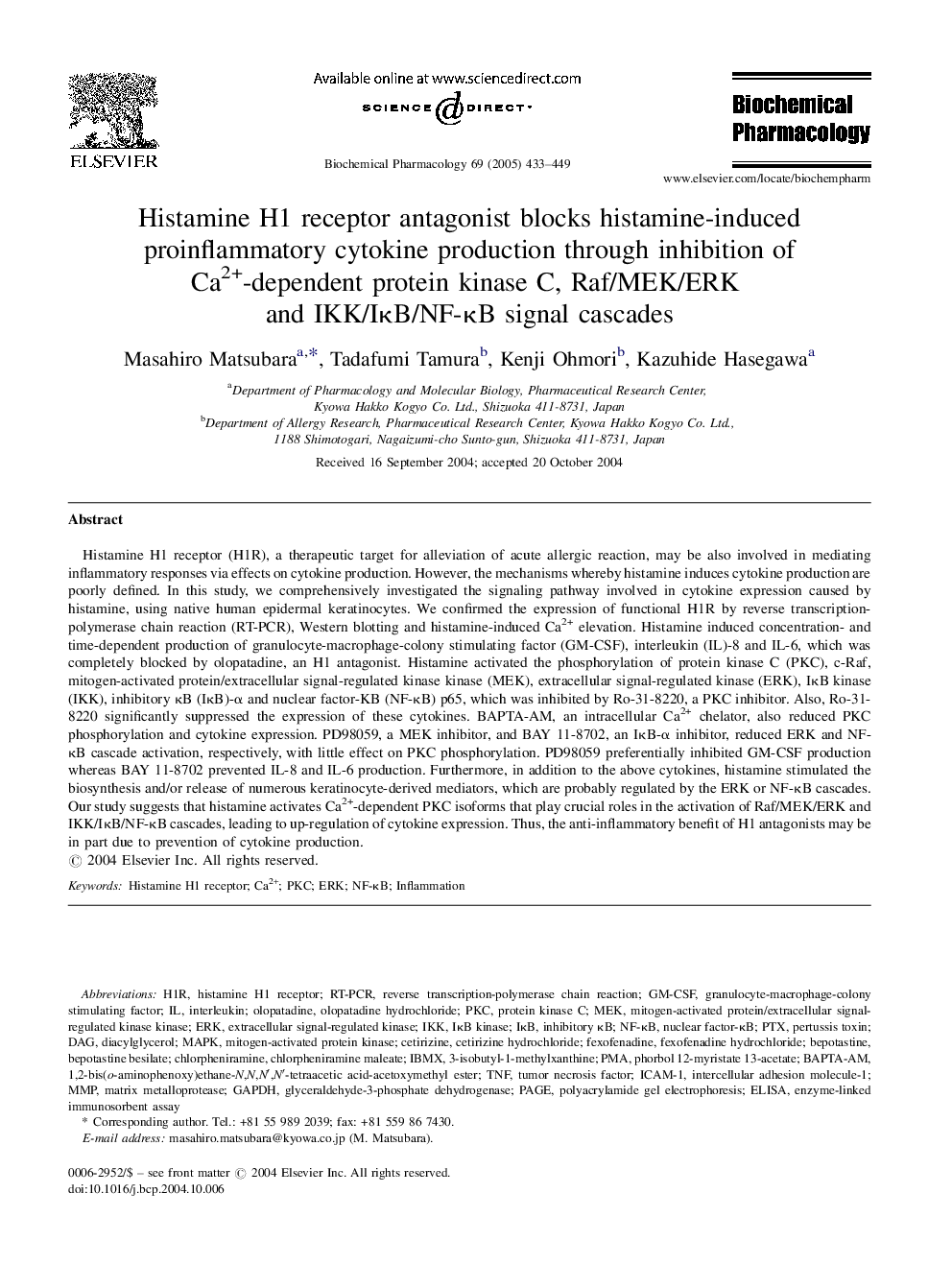| Article ID | Journal | Published Year | Pages | File Type |
|---|---|---|---|---|
| 9002175 | Biochemical Pharmacology | 2005 | 17 Pages |
Abstract
Histamine H1 receptor (H1R), a therapeutic target for alleviation of acute allergic reaction, may be also involved in mediating inflammatory responses via effects on cytokine production. However, the mechanisms whereby histamine induces cytokine production are poorly defined. In this study, we comprehensively investigated the signaling pathway involved in cytokine expression caused by histamine, using native human epidermal keratinocytes. We confirmed the expression of functional H1R by reverse transcription-polymerase chain reaction (RT-PCR), Western blotting and histamine-induced Ca2+ elevation. Histamine induced concentration- and time-dependent production of granulocyte-macrophage-colony stimulating factor (GM-CSF), interleukin (IL)-8 and IL-6, which was completely blocked by olopatadine, an H1 antagonist. Histamine activated the phosphorylation of protein kinase C (PKC), c-Raf, mitogen-activated protein/extracellular signal-regulated kinase kinase (MEK), extracellular signal-regulated kinase (ERK), IκB kinase (IKK), inhibitory κB (IκB)-α and nuclear factor-KB (NF-κB) p65, which was inhibited by Ro-31-8220, a PKC inhibitor. Also, Ro-31-8220 significantly suppressed the expression of these cytokines. BAPTA-AM, an intracellular Ca2+ chelator, also reduced PKC phosphorylation and cytokine expression. PD98059, a MEK inhibitor, and BAY 11-8702, an IκB-α inhibitor, reduced ERK and NF-κB cascade activation, respectively, with little effect on PKC phosphorylation. PD98059 preferentially inhibited GM-CSF production whereas BAY 11-8702 prevented IL-8 and IL-6 production. Furthermore, in addition to the above cytokines, histamine stimulated the biosynthesis and/or release of numerous keratinocyte-derived mediators, which are probably regulated by the ERK or NF-κB cascades. Our study suggests that histamine activates Ca2+-dependent PKC isoforms that play crucial roles in the activation of Raf/MEK/ERK and IKK/IκB/NF-κB cascades, leading to up-regulation of cytokine expression. Thus, the anti-inflammatory benefit of H1 antagonists may be in part due to prevention of cytokine production.
Keywords
mitogen-activated protein/extracellular signal-regulated kinase kinasePTXPKCIKKGM-CSFNF-κBphorbol 12-myristate 13-acetateIκBH1RPAGEFexofenadineERKICAM-1MMPgranulocyte-macrophage-colony stimulating factorIBMXTNFFexofenadine hydrochlorideGAPDHRT-PCR3-isobutyl-1-methylxanthineCa2+IκB kinasePMAMAPKinflammationpolyacrylamide gel electrophoresisOlopatadineOlopatadine hydrochlorideinterleukinBAPTA-AMELISAEnzyme-linked immunosorbent assaydiacylglycerolDAGpertussis toxinCetirizinetumor necrosis factornuclear factor-κBMatrix metalloproteaseMEKinhibitory κBintercellular adhesion molecule-1reverse transcription-polymerase chain reactionProtein kinase Cmitogen-activated protein kinaseChlorpheniramine maleateChlorpheniramineextracellular signal-regulated kinaseglyceraldehyde-3-phosphate dehydrogenasehistamine H1 receptor
Related Topics
Health Sciences
Pharmacology, Toxicology and Pharmaceutical Science
Pharmacology
Authors
Masahiro Matsubara, Tadafumi Tamura, Kenji Ohmori, Kazuhide Hasegawa,
